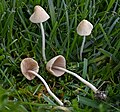Conocybe apala
Conocybe apala, also known as the fragile conecap or white dunce cap, is a species of mushroom in the family Bolbitiaceae. This small, delicate mushroom is often found in lawns and grassy areas in Europe and North America, particularly during the wetter months of summer and autumn. Despite its unassuming appearance, Conocybe apala is a species of interest within the field of mycology due to its distinctive characteristics and its role in the ecosystem.
Description
Conocybe apala mushrooms are characterized by their small size, fragile structure, and pale coloration. The cap is conical or bell-shaped, measuring 1-2.5 cm in diameter, and is often a pale white or cream color. The stem is thin and fragile, growing up to 6 cm tall and 2-3 mm thick, with a similar coloration to the cap. These mushrooms do not have a ring on the stem, and the gills are adnate to adnexed, ranging in color from light brown to a more cinnamon hue as the spores mature.
Habitat and Distribution
The fragile conecap is commonly found in grassy areas, such as lawns, meadows, and parks, where it grows in small groups or clusters. It has a widespread distribution, occurring in both Europe and North America. The mushroom prefers moist conditions and is most commonly observed following periods of rain during the warmer months.
Ecology
As a saprotrophic organism, Conocybe apala plays a crucial role in its ecosystem by decomposing organic matter. This process recycles nutrients back into the soil, supporting plant growth and maintaining the health of the ecosystem. The species is part of a larger genus, Conocybe, which includes many other saprotrophic mushrooms.
Toxicity
While Conocybe apala is not known to contain the same potent toxins as some of its relatives in the genus Conocybe, such as those containing psilocybin, it is generally advised to avoid consumption. The fragile conecap has not been extensively studied for its edibility, and the risk of mistaking it for other toxic species makes it a poor choice for foraging.
Research and Conservation
Research on Conocybe apala and its relatives is ongoing, with studies focusing on their taxonomy, ecology, and potential uses in bioremediation. As a common species, Conocybe apala does not currently face any significant conservation threats. However, monitoring its population and distribution can provide valuable insights into the health of grassland ecosystems.
See Also
References
Species of fungus
| Conocybe apala | |
|---|---|
| Gills on hymenium | |
| Cap is conical | |
| Hymenium is adnate | |
| Stipe is bare | |
| Spore print is brown | |
| Ecology is saprotrophic | |
| Edibility is inedible | |
Transform your life with W8MD's budget GLP-1 injections from $125.
W8MD offers a medical weight loss program to lose weight in Philadelphia. Our physician-supervised medical weight loss provides:
- Most insurances accepted or discounted self-pay rates. We will obtain insurance prior authorizations if needed.
- Generic GLP1 weight loss injections from $125 for the starting dose.
- Also offer prescription weight loss medications including Phentermine, Qsymia, Diethylpropion, Contrave etc.
NYC weight loss doctor appointments
Start your NYC weight loss journey today at our NYC medical weight loss and Philadelphia medical weight loss clinics.
- Call 718-946-5500 to lose weight in NYC or for medical weight loss in Philadelphia 215-676-2334.
- Tags:NYC medical weight loss, Philadelphia lose weight Zepbound NYC, Budget GLP1 weight loss injections, Wegovy Philadelphia, Wegovy NYC, Philadelphia medical weight loss, Brookly weight loss and Wegovy NYC
|
WikiMD's Wellness Encyclopedia |
| Let Food Be Thy Medicine Medicine Thy Food - Hippocrates |
Medical Disclaimer: WikiMD is not a substitute for professional medical advice. The information on WikiMD is provided as an information resource only, may be incorrect, outdated or misleading, and is not to be used or relied on for any diagnostic or treatment purposes. Please consult your health care provider before making any healthcare decisions or for guidance about a specific medical condition. WikiMD expressly disclaims responsibility, and shall have no liability, for any damages, loss, injury, or liability whatsoever suffered as a result of your reliance on the information contained in this site. By visiting this site you agree to the foregoing terms and conditions, which may from time to time be changed or supplemented by WikiMD. If you do not agree to the foregoing terms and conditions, you should not enter or use this site. See full disclaimer.
Credits:Most images are courtesy of Wikimedia commons, and templates, categories Wikipedia, licensed under CC BY SA or similar.
Contributors: Prab R. Tumpati, MD



